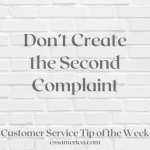
Sometimes the facts are not enough. The customer is irate, or they don’t like the alternative you’re suggesting. You need them to do something, and they want you to do it. They need to do options A or B, and they want to select imaginary option Z.
You need to persuade them so that the right choice or a reasonable choice or the best choice for them is the one they select. So how do you unleash your persuasiveness?
Here are four (4) key points of consideration:
- Identify what’s in it for them, or how it would benefit them. Then reference this in the conversation. The customer is more easily persuaded to take a certain action if they understand the benefit to them of taking that action. Instead of purely understanding what needs to be done and understanding why it’s beneficial to you or your organization, use a little empathy to understand what’s in it for them.
- Model positive behaviors – nods, eye contact, smiles. Persuasion is not just about the words you use. Persuasion is something where they are feeling the positive energy associated with the option you’re promoting. They feel the confidence that you have not only in what you say but how you’re saying it. They feel a level of sincerity in the message you’re sending. You do this with your body language and tone of voice as much as you do it with your words.
- Build their confidence by sharing successful experiences in a simple/relatable way. Let them know you’ve done this successfully with others. Oftentimes, customers come into situations with one solution in mind, and if that solution is not the one you’re suggesting, they need to be able to envision a successful outcome clearly like they’ve already envisioned that outcome using their own solution. So talk about other customers that have successfully utilized this option; talk about clients similar to them where this has worked well. Keep it simple, and make sure they can relate to the examples of success you provide.
- Uncover their concerns with the potential solution/alternative. In the end, what you’re really doing is overcoming their fears and concerns about the option that you’re providing. So ask them why they would prefer a certain option. Ask them what in particular is causing them to hesitate about selecting a particular alternative. The more you can uncover the specific concerns, the better you can address them.
Unleash your innate persuasiveness!
Signup for FREE Tips! Contact Us More Resources for You Visit Our Home Page























